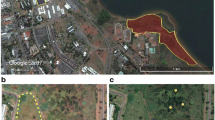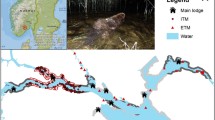Abstract
Two wild members of the camel family occur on the aridlands of South America: the vicuna (Vicugna vicugna) and the guanaco (Lama guanicoe). The vicuna is found in the central Andean altiplano or puna, an equatorial short-grassland that is above treeline and below the snowline, despite its 3700m to 4800m elevation (Koford, 1957; Franklin, 1973 a, b). In contrast, the guanaco ranges from sea level to 4000m and is more widely distributed (Franklin, 1975).
Access this chapter
Tax calculation will be finalised at checkout
Purchases are for personal use only
Preview
Unable to display preview. Download preview PDF.
Similar content being viewed by others
References
Altmann, D. 1969. Harnen und Koten bei SHugetieren. NeueBrehm- Bücherei No. 404. Wittenberg-Lutherstadt: Ziemsen.
Bindra, D. and W.R. Thompson. 1953. An evaluation of defecation and urination as measures of fearfulness. J. Comp. Physiol. Psychol, 461: 43–45.
Eisenberg, J.F. and D.G. Kleiman. 1972. Olfactory communication in mammals. Ann. Rev. Ecol. and Syst. 3: 1–32.
Franklin, W.L. 1971. Vicuna survey, Peru. Pp. 145–148. In P. Jackson (Ed.). World Wildlife Yearbook 1970–71. World Wildlife Fund, Morges. 300 pp.
Franklin, W.L. 1973b. To save the vicuna. Americas 25: 2–10.
Franklin, W.L. 1974. The social behavior of the vicuna. Pp. 477- 487. V. Geist and F. Walther (Eds.) The behaviour of ungulates and its relation to management. I.U.C.N., Morges. 940.
Franklin, W.L. Guanacos in Peru. Oryx 13: 191–202. 1978.
Franklin, W.L. The socioecology of the vicuna. Ph.D. Thesis, Utah State University, Logan, Utah. 167 pp.
Johnson, R.P. 1973. Scent marking in mammals. Anim. Behav. 21: 521–535.
Koford, C.B. 1957. The vicuna and puna. Ecol. Monogr. 27: 153–219.
Leuthold, W. 1977. African ungulates: a comparative review of their ethology and behavioral ecology. Springer-Verlag, New York. 307 pp.
Müller-Schwarze, D., C. Müller-Schwarze, and W.L. Franklin. 1973. Factors influencing scent-marking in the pronghorn (Antilocapra americana). Verhandlungen der Deutschen Zoologischen Gesellschaft 66: 146–150.
Pilters, H. 1956. Das Verhalten der Tylopoden. Handbuch der Zoolgie 8(10) No. 27, 1–24.
Ralls, K. 1971. Mammalian scent marking. Science 171: 443–449.
Author information
Authors and Affiliations
Editor information
Editors and Affiliations
Rights and permissions
Copyright information
© 1980 Plenum Press, New York
About this chapter
Cite this chapter
Franklin, W.L. (1980). Territorial Marking Behavior by the South American Vicuna. In: Müller-Schwarze, D., Silverstein, R.M. (eds) Chemical Signals. Springer, Boston, MA. https://doi.org/10.1007/978-1-4684-1027-3_5
Download citation
DOI: https://doi.org/10.1007/978-1-4684-1027-3_5
Publisher Name: Springer, Boston, MA
Print ISBN: 978-1-4684-1029-7
Online ISBN: 978-1-4684-1027-3
eBook Packages: Springer Book Archive




